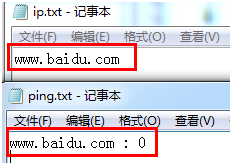Python subprocess模块详细解读,pythonsubprocess
Python subprocess模块详细解读,pythonsubprocess
本文研究的主要是Python subprocess模块的相关内容,具体如下。
在学习这个模块前,我们先用Python的help()函数查看一下subprocess模块是干嘛的:
DESCRIPTION
This module allows you to spawn processes, connect to their
input/output/error pipes, and obtain their return codes.
即允许你去创建一个新的进程让其执行另外的程序,并与它进行通信,获取标准的输入、标准输出、标准错误以及返回码等。
注意:使用这个模块之前要先引入该模块。
Popen类
subprocess模块中定义了一个Popen类,通过它可以来创建进程,并与其进行复杂的交互。查看一下它的构造函数:
__init__(self, args, bufsize=0, executable=None, stdin=None, stdout=None, stderr=None, preexec_fn=None, close_fds=False, shell=False, cwd=None, env=None, universal_newlines=False, startupinfo=None, creationflags=0)
主要参数说明:
args:args should be a string, or a sequence of program arguments.也就是说必须是一个字符串或者序列类型(如:字符串、list、元组),用于指定进程的可执行文件及其参数。如果是一个序列类型参数,则序列的第一个元素通常都必须是一个可执行文件的路径。当然也可以使用executeable参数来指定可执行文件的路径。
stdin,stdout,stderr:分别表示程序的标准输入、标准输出、标准错误。有效的值可以是PIPE,存在的文件描述符,存在的文件对象或None,如果为None需从父进程继承过来,stdout可以是PIPE,表示对子进程创建一个管道,stderr可以是STDOUT,表示标准错误数据应该从应用程序中捕获并作为标准输出流stdout的文件句柄。
shell:如果这个参数被设置为True,程序将通过shell来执行。
env:它描述的是子进程的环境变量。如果为None,子进程的环境变量将从父进程继承而来。
创建Popen类的实例对象
res = subprocess.Popen(cmd, shell=True, stdout=subprocess.PIPE, stderr=subprocess.STDOUT)
cmd:标准像子进程传入需要执行的shell命令,如:ls -al
subprocess.PIPE:在创建Popen对象时,subprocess.PIPE可以初始化为stdin, stdout或stderr的参数,表示与子进程通信的标准输入流,标准输出流以及标准错误。
subprocess.STDOUT:作为Popen对象的stderr的参数,表示将标准错误通过标准输出流输出。
Popen类拥有的方法及属性
1、Popen.pid
获取子进程的进程ID。
2、Popen.returncode
获取进程的返回码。如果进程未结束,将返回None。
3、communicate(input=None)
官方解释:
Interact with process: Send data to stdin. Read data from
stdout and stderr, until end-of-file is reached. Wait for
process to terminate. The optional input argument should be a
string to be sent to the child process, or None, if no data
should be sent to the child.communicate() returns a tuple (stdout, stderr).
与子进程进行交互,像stdin发送数据,并从stdout和stderr读出数据存在一个tuple中并返回。
参数input应该是一个发送给子进程的字符串,如果未指定数据,将传入None。
4、poll()
检查子进程是否结束,并返回returncode属性。
5、wait()
Wait for child process to terminate. Returns returncode attribute.
等待子进程执行结束,并返回returncode属性,如果为0表示执行成功。
6、send_signal( sig)
Send a signal to the process
发送信号给子进程。
7、terminate()
Terminates the process
终止子进程。windows下将调用Windows API TerminateProcess()来结束子进程。
8、kill()
官方文档对这个函数的解释跟terminate()是一样的,表示杀死子进程。
进程通信实例1
打开一个只有ip地址的文本文件,读取其中的ip,然后进行ping操作,并将ping结果写入ping.txt文件中。
首先创建一个子进程res,传入要执行的shell命令,并获得标准输出流、返回码等。
import subprocess
import os
class Shell(object) :
def runCmd(self, cmd) :
res = subprocess.Popen(cmd, shell=True, stdout=subprocess.PIPE, stderr=subprocess.STDOUT)
sout ,serr = res.communicate()
return res.returncode, sout, serr, res.pid
shell = Shell()
fp = open('c:\\test\\ip.txt', 'r')
ipList = fp.readlines()
fp.close()
fp = open('c:\\test\\ping.txt', 'a')
print ipList
for i in ipList :
i = i.strip()
result = shell.runCmd('ping ' + i)
if result[0] == 0 :
w = i + ' : 0'
fp.write(w + '\n')
else :
w = i + ' : 1'
fp.write(w + '\n')
fp.close()
执行结果:

进程通信实例2
命令交互,不断从键盘接受命令执行,给出执行结果,直到用户输入exit或者bye退出命令交互。
import subprocess
class Shell(object) :
def runCmd(self, cmd) :
res = subprocess.Popen(cmd, shell=True, stdout=subprocess.PIPE, stderr=subprocess.STDOUT)
sout ,serr = res.communicate()
return res.returncode, sout, serr, res.pid
shell = Shell()
while 1 :
input = raw_input('>')
if input == 'exit' or input == 'bye' :
break
else :
result = shell.runCmd(input)
print "返回码:", result[0]
print "标准输出:", result[1]
print "标准错误:", result[2]
在Windows上也可以使用os.system()这个函数来执行一些dos命令,但是这个命令只能拿到返回码,拿不到标准输出,标准错误,所以通常使用的subprocess模块中的Popen类来实现。
总结
以上就是本文关于Python subprocess模块详细解读的全部内容,希望对大家有所帮助。感兴趣的朋友可以继续参阅本站其他相关专题,如有不足之处,欢迎留言指出。感谢朋友们对本站的支持!
相关内容
- Python使用遗传算法解决最大流问题,python遗传算法
- Python中的默认参数实例分析,python参数实例分析
- python列表的增删改查实例代码,python实例
- python实现简易版计算器,python实现计算器
- python链接oracle数据库以及数据库的增删改查实例,pyt
- Python使用wxPython实现计算器,pythonwxpython
- python操作oracle的完整教程分享,pythonoracle教程
- python 连接各类主流数据库的实例代码,python实例
- python3.5 tkinter实现页面跳转,python3.5tkinter
- Python操作MySQL数据库的三种方法总结,pythonmysql
评论关闭